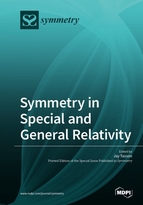Symmetry in Special and General Relativity
A special issue of Symmetry (ISSN 2073-8994). This special issue belongs to the section "Physics".
Deadline for manuscript submissions: closed (5 November 2019) | Viewed by 19440
Special Issue Editor
Special Issue Information
Dear Colleagues,
Symmetry has played a critical role in the development of special and general relativity, and it plays an ongoing role in testing these theories. Lorentz symmetry in particular lies at the foundation of our current best theories of physics. Searches for evidence of broken Lorentz symmetry, along with the associated CPT symmetry and other spacetime symmetries, have become a popular approach to seeking new physics. One particularly exciting motivation is the hope of detecting new physics originating at the notoriously difficult to access Planck scale. The search for such symmetry violations is broad, spanning most areas of contemporary physics.
In this Special Issue of Symmetry, we explore ideas of symmetry in the foundations and teaching of relativity, as well as in modern efforts to test the symmetries of special and general relativity.
Dr. Jay Tasson
Guest Editor
Manuscript Submission Information
Manuscripts should be submitted online at www.mdpi.com by registering and logging in to this website. Once you are registered, click here to go to the submission form. Manuscripts can be submitted until the deadline. All submissions that pass pre-check are peer-reviewed. Accepted papers will be published continuously in the journal (as soon as accepted) and will be listed together on the special issue website. Research articles, review articles as well as short communications are invited. For planned papers, a title and short abstract (about 100 words) can be sent to the Editorial Office for announcement on this website.
Submitted manuscripts should not have been published previously, nor be under consideration for publication elsewhere (except conference proceedings papers). All manuscripts are thoroughly refereed through a single-blind peer-review process. A guide for authors and other relevant information for submission of manuscripts is available on the Instructions for Authors page. Symmetry is an international peer-reviewed open access monthly journal published by MDPI.
Please visit the Instructions for Authors page before submitting a manuscript. The Article Processing Charge (APC) for publication in this open access journal is 2400 CHF (Swiss Francs). Submitted papers should be well formatted and use good English. Authors may use MDPI's English editing service prior to publication or during author revisions.
Keywords
- Special relativity
- General relativity
- Spacetime symmetry
- Lorentz symmetry
- Lorentz violation
- Tests of relativity
- CPT
- Standard-model extension
- Finsler geometry






